Invoicing
Convergence generates invoices on request based on case note data, with the possibility to entering additional charges not in case notes, and accounting for retainers for cases. Invoices may be output in different formats, either user definable templates, or as an Excel compatible spreadsheet.
Invoice Items and Case Notes
Each invoice contains invoice items, line items with a billable amount or credit associated with each one. All invoice items are associated with a case note, and case notes are marked as invoiced or not depending on whether they have an active invoice item in an invoice yet. An invoice item may contain more than one case note if case notes are combined into a line item. The "+" button next to an invoice item will pop out a list of what case notes make up the item. Invoice items may also be added directly to an invoice without creating a case note first, to add in any additional charges or credits beyond the existing case activities. When an extra invoice item is added, a new case note is automatically created to correspond to the new invoice item. If a retainer is entered for a case, that will show up as a credit if it not already been credited to an invoice for the current case.
Adding New Invoices
To start a new invoice for the current case, simply click 'New Invoice' in the popup menu or navigation page. The invoice items will automatically be populated with any non-invoiced case notes for the current case that have a billable value. In addition, any retainer for the case that is not already in an invoice will be included as a credit.
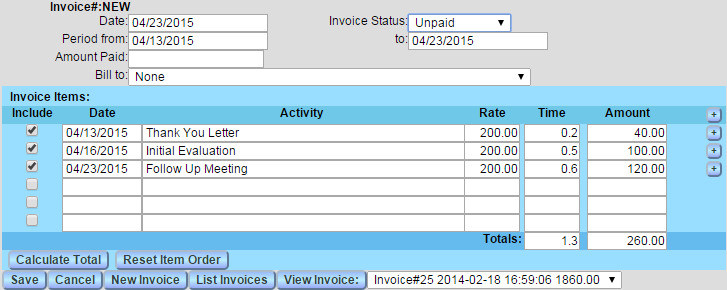
The check boxes in the 'Include' column control whether or not a particular invoice item will be included in this invoice or not. There are always three blank invoice items at the bottom of the list so you may enter any additional items not from case notes. The total hours and amount at the bottom of the list are automatically updated whenever an amount or number of hours is changed.
The invoice status indicates whether an invoice has been paid, is pending, or is overdue.

The 'Bill To:' menu lists the possible billing parties, the available contacts for the case, going through the client and all contact types, filling in organization and contact names where found.
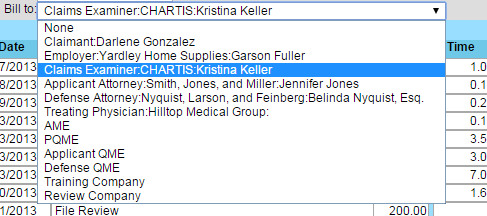
The name and address from the billable party will show up on an invoice template, and a billable party is necessary to generate an outstanding balance on later invoices.
To add an extra line item to the invoice by hand, check the 'Include' box for a blank item, and enter the name and amount for the item. The item name field will pop up suggestions of existing item names to autofill, to assure that activity names remain consistent. Hourly rate and hours may be entered if applicable. The amount will be autocalculated from hours and rate if they are available.

Your new invoice will save when you go to another page, unless you click the 'Cancel' button. The 'Save' button saves your invoice and returns to the invoice editing page. Your browser's back button also backs out without saving.
Invoice Lists
To get an invoice list, click 'List Invoices' in the popup menu or navigation page, or click the button 'List Invoices' on the invoice page.

The link 'View' will give you a printable view of the invoice, based on the standard invoice template. The 'Edit' link for each invoice will go to the edit invoice page.
The '+' button will pop out a list of the invoice items that make up this invoice. Each activity name is linked to the case note that corresponds to that invoice item.
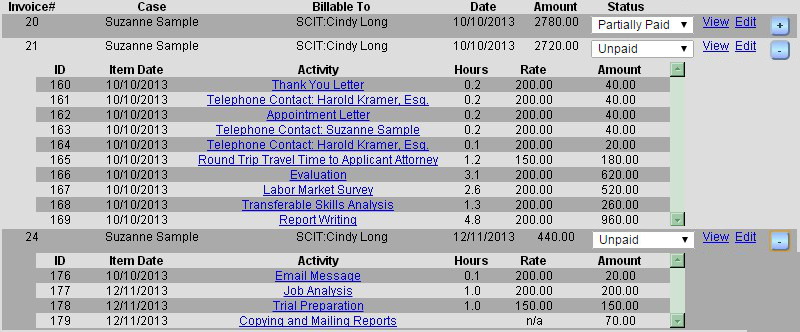
The Status column contains menus indicating the current status of the invoice, and allowing users to change that status, for example to make an unpaid invoice as paid. When an invoice status is changed to 'Paid' or 'Partially Paid' a popup appears to ask for a payment date and a payment amount. Clicking 'Save' will change the invoice status and redisplay the list. If the status is changed to 'Unpaid' the list simply refreshes with the new status.

If there are any Invoice Report templates, a button 'Get Report:' appears below the list with a menu to select an invoice report type. Select the report and click the button to see a report.
This same invoice list format and features are used to display the results of an invoice search.
Editing Invoices
To edit an existing invoice, click the 'Edit' link from an invoice list, or on the invoice page, select an invoice from the menu in the lower right and click 'View Invoice:'. If you have the privilege you may modify the invoice and add or remove invoice items.
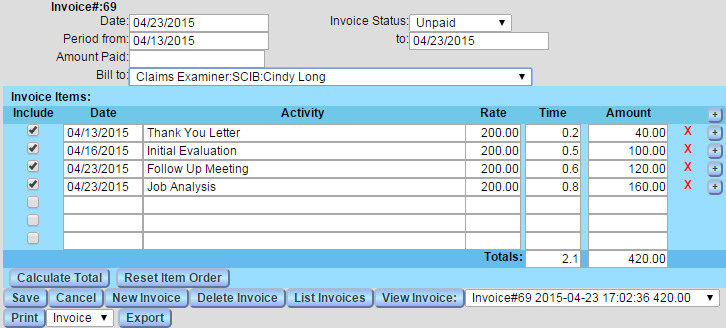
If you are editing an existing invoice, extra buttons appear for deleting the invoice, printing it from a template, or exporting it to an Excel compatible spreadsheet. The red 'X' links to the right will delete invoice items after you confirm. You can also remove items by unchecking the 'Include' checkboxes to the left. Clicking the red 'X' also deletes the corresponding case note, unchecking the box leaves the case note free to be assigned to another invoice. The '+' buttons expand a view of what case note or notes correspond to this line item. See below for details. In the picture below, some items in the invoice screen are dimmed because their 'Include' checkbox is not checked. When you edit an existing invoice, and there are new, uninvoiced notes, they will show up in the list, but not included unless you choose to add them to that existing invoice by checking 'Include'. There is no red 'X' next to these entries because they are not yet part of the invoice, and so can't be removed from it.

Reordering Invoice Items
By default, all invoice items appear ordered by the date of the case note they are for. Sometimes, a different order may be needed, so items can be reordered by dragging them to the desired place in the invoice item list. Just grab an item with the mouse, near but not in the date and Include check box, and drag it to where it will go. This new item order will be saved when the invoice is saved.

Combining Invoice Items
The '+' button for each invoice item opens a list of the case note or notes that account for this line item. The '+' button at the top of the list opens all the case note lists for all items at once.

When case notes are visible, they may be dragged and dropped into other invoice items to create combined items.

The blue '^' up arrows will take a note from an item's list and put it back in it's own line item by itself, basically undoing the drag and drop to combine notes. Case notes may be combined only if they have the same hourly rate, or all have no hourly rate. If notes of different acitvity names are combined, the invoice item will be titled for the original note from before combining. In the Admin Preferences section, there is a setting 'Combine Notes of same date and activity for invoicing', which if checked will cause notes with the same date and activity to be automatically combined into one line item when a new invoice is being created, if those notes were not already in another invoice. The feature can be turned on or off only by the admin user.
Note that there are two different mouse drag functions in the invoice item list. Grabbing the item (the lighter blue part) will move it up or down the item list. Grabbing a case note inside an item (the darker blue part when the item is expanded) will move the note to combine it with a different item.
Outstanding Balance
If, for an invoice, there are previous invoices billable to the same party that are marked Unpaid, an outstanding balance exists. This will be displayed in the invoice editor like this:

The outstanding balance is automatically included in the invoice total. If an invoice document is generated, it will reflect the outstanding balance as of the time of document generation. For invoice document templates, there is a special repeat designation 'Outstanding' to aid in creating itemized outstanding balances on invoice printouts.
Partial payments may be recorded and applied to outstanding balances. If the Invoice Status field has an option containing the word 'Partial', and there is a custom field named 'partialamount' or 'amountpaid', the amount in that field will be applied to the outstanding balance if the status 'Partial...' is chosen.
Invoice Templates
One of the types of document templates are invoice templates. Those with the privilege to edit templates may create whatever invoice format is desired, and can create multiple invoice templates to use with different invoices. The 'Print' button on the edit invoice page is followed by a menu of invoice templates from the database. The templates are listed alphabetically by name in the menu, and the lowest in the alphabet is the default. Below is an example of an invoice generated with the standard template that installs with Convergence. This template may be modified or replaced by a user with the privilege to create templates.
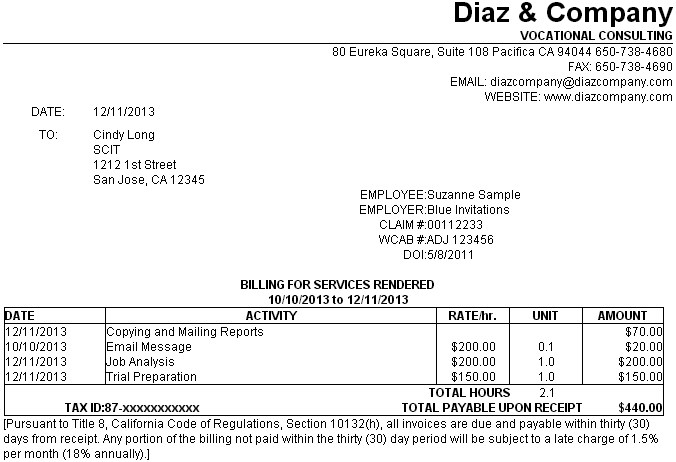
The company name and contact info would be for your organization rather than for Diaz & Company. Your company information is entered by the admin user in the Preferences page.
Invoice Export
The 'Export' button on the edit invoice page will generate and download an Excel compatible spreadsheet file. Below is the same invoice as it appears in Excel after the export file has been downloaded and opened.
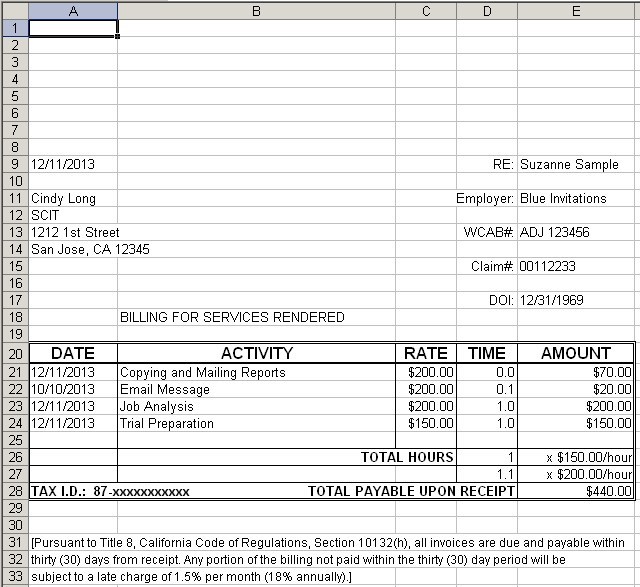
This document format is not template based, and the Excel export is available as is.
Invoice Search
The invoice search page can be reached through the link 'Find Invoices' in the 'Invoices' section of the navigation page.
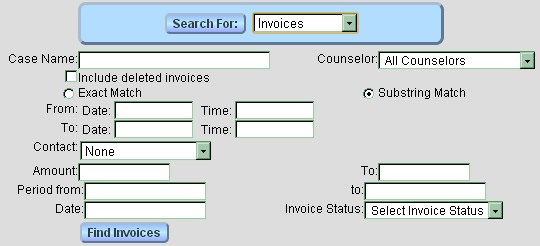
The results of your search will be an invoice list as shown below. It has all the same features as the case invoice list page.

This manual is published by Convergence Case Management Data Retrieval Software, LLC, whose software products are provided for use by parties who have paid for and have a current license to operate the software described herein.
Information in this manual is subject to change without notice, and does not represent any commitment on the part of Convergence Case Management Data Retrieval Software, LLC. The software described in this manual is furnished under a license agreement and may be used only in accordance with its terms and conditions.
© Copyright 2025 Convergence Case Management Data Retrieval Software, LLC
This manual contains propietary information which is protected by Copyright. No part of this document may be reproduced, translated into any language or computer language, or transmitted in any form whatsoever without the prior written consent of Convergence Case Management Data Retrieval Software, LLC.
